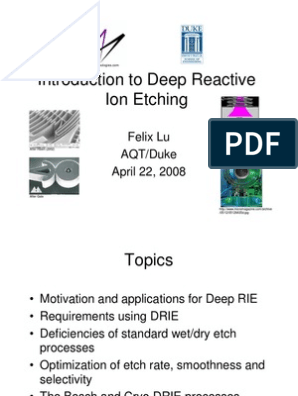0% found this document useful (0 votes)
17 views23 pagesSection 3 - Etching
The document discusses various aspects of the etching process, including figures of merit such as etch rate, selectivity, and anisotropy. It compares wet etching and reactive ion etching (RIE), detailing the processes, materials used, and their respective advantages and drawbacks. Additionally, it explains how to control anisotropy and selectivity during the etching process.
Uploaded by
lucylu20020108Copyright
© © All Rights Reserved
We take content rights seriously. If you suspect this is your content, claim it here.
Available Formats
Download as PPT, PDF, TXT or read online on Scribd
0% found this document useful (0 votes)
17 views23 pagesSection 3 - Etching
The document discusses various aspects of the etching process, including figures of merit such as etch rate, selectivity, and anisotropy. It compares wet etching and reactive ion etching (RIE), detailing the processes, materials used, and their respective advantages and drawbacks. Additionally, it explains how to control anisotropy and selectivity during the etching process.
Uploaded by
lucylu20020108Copyright
© © All Rights Reserved
We take content rights seriously. If you suspect this is your content, claim it here.
Available Formats
Download as PPT, PDF, TXT or read online on Scribd
/ 23






















































































